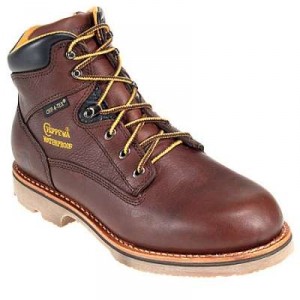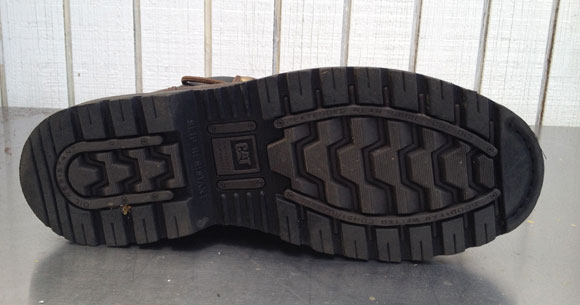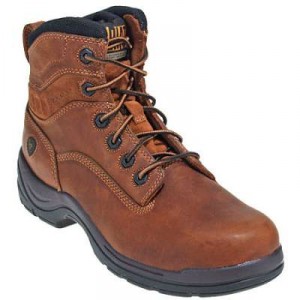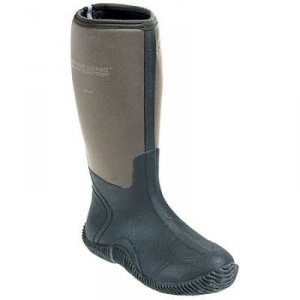There are over 800 known ways to make a shoe, but most are variations of a few basic methods or constructions. The term sole construction is simply the method used to attach the sole to the upper of safety footwear.
The most common constructions for safety footwear are:
Goodyear Welt Construction: This method is considered the traditional construction for sturdy, well-made footwear. It is used almost exclusively on better shoes and most men’s shoes. Goodyear Welt Construction uses an insole with a wall or rib that is positioned close to the edge of the insole. During lasting, the upper is secured to this wall. The welt is then sewn in and attaches to the wall of the insole. The sole is then positioned with an adhesive to the shoe bottom and is stitched through the welt. This creates an indirect attachment since the sole is not directly attached to the upper. This is among the most labor intensive methods of shoemaking, and thus the most expensive.

Cement Construction: Introduced in 1928, this is the most commonly used construction for safety footwear. With cement construction, the outsole is attached to the insole and upper material with a very firm bonding adhesive and pressed together. Cement constructed shoes are generally light, flexible and make for better-looking dress shoes.
Heat Sealing Construction: There are two types of heat sealing construction, vulcanized and injection molded. The main difference is that vulcanized soles are rubber and injection molded soles are a plastic material. In either case, the sole is very long wearing which extends the life of the footwear.
Vulcanizing: the outsole and upper are combined and molded together with a band of soft rubber, which is then pressed in place, heated in a vulcanizing oven and allowed to cool.
Injection molded: outsoles start as a soft plastic substance that is poured into a sole-shaped metal mold. The shoe’s upper is then pressed down against the mold. The soling material quickly hardens and is molded in a permanent bond to the upper.
CONSTRUCTION | CAN RESOLE | FLEXIBLE | LIGHTWEIGHT |
| DIRECT ATTACH | X | X | |
| CEMENT | X | X | |
| GOODYEAR WELT | X | ||
| SUPERSOLE | X | X | |
| STITCHDOWN | X | X | |
| 360° | X |
OUTSOLE MATERIALS
MATERIAL | OIL | HEAT | SLIP |
| RUBBER | X | X | X |
| CREPE | X | ||
| POLYURETHANE | X | X | |
| TPU | X | X | X |
| NITRILE | X | X | |
| CORK |
SLIP RESISTANCE
For all intents and purposes, not all footwear is slip resistant. It is your job to determine the best sole for a particular customer’s work environment. No sole is designed for all surfaces and conditions. In other words, there is no such thing as slip proof safety footwear at this time.
Customers needing specific slip resistance data for safety footwear are really asking for James Test results. The James Test is a standard test performed by independent laboratories. Soles are tested for slippage on dry, wet, oily (7 drops of vegetable oil), oil/wet (2 drops of vegetable oil plus 25/mls distilled water) conditions on red quarry tile.
MIDSOLE MATERIALS
RUBBER – EVA – ABZORB® – POLYURETHANE
SHANK MATERIALS
STEEL – FIBERGLASS – BAMBOO – NYLON – WOOD
PROPRIETARY SOLES
| DURASHOCKS | WOLVERINE | POLYURETHANE |
| COMPRESSOR | WOLVERINE | TPU |
| COMFORT CORE | GEORGIA | RUBBER OR POLYURETHANE |
| 4X4 | CAROLINA | RUBBER |
| TRUE-TRACKS | DUNHAM | RUBBER |
| MELLINIUM | CAROLINA | RUBBER |
| BILTRITE | VARIOUS | RUBBER AND KEVLAR |
| DOUBLE COMFORT | JUSTIN | POLYURETHANE |
Working Person’s Store carries a variety of safety footwear which includes the previously stated sole construction, outsole, midsole and shank materials along with slip resistance features. Log on to WorkingPerson.com and search for the perfect pair of work or safety footwear to match the needs of your specific work environments.






